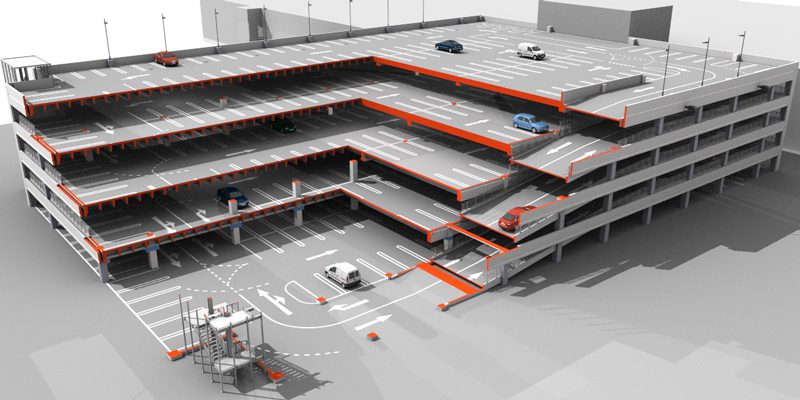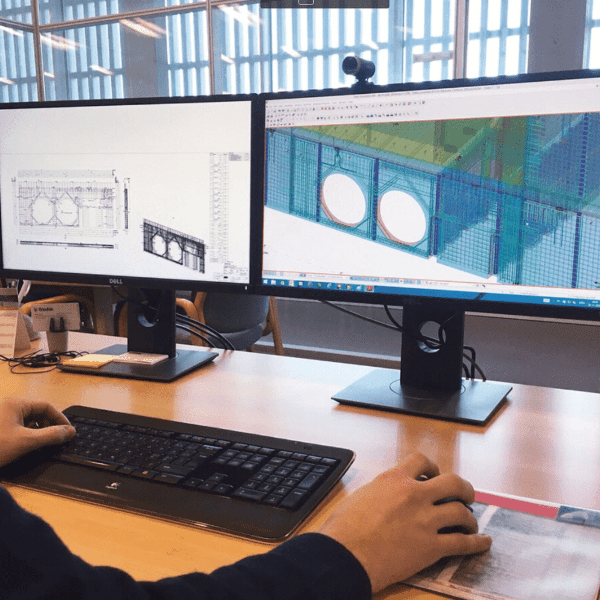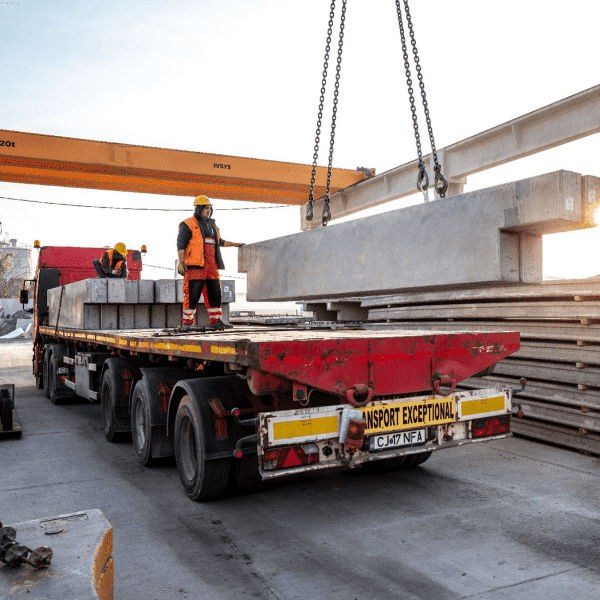
Fast assembly
Constructing with precast reinforced concrete elements saves a considerable amount of time. The proportion of work at the construction site is small – while preparations and foundations are being made at the construction site, the elements of the car park are being manufactured at the plant. Since it is a mass production and the time period for assembly is short, it saves a lot of time. It is possible to build approximately 1,000-1,500 m in one week.
Elements are like Lego bricks which can be used to quickly assemble buildings of different shapes. The plant-made solution has many advantages compared to cast-in-situ solutions.
Quality
The element solution ensures an end result of high quality, since the all-year-round conditions are considerably better at the plant than at the construction site. Plant’s controlled conditions make it easy to manufacture high quality concrete and ensure the desired properties of the material. Concrete itself is very resistant in a chemically aggressive environment.
Fewer columns reduce fear of parking
A car park made of precast concrete elements is spacious – there are no columns which would make parking more complicated. The number of columns in the building is smaller due to long-span prestressed concrete panels. This way, the space under the roof is not filled with columns which would otherwise limit the use of space.
Many different finishing possibilities
The possibilities of concrete as a material are diverse. Various relief shapes, stone colours and treatments can be used to make the surface of concrete interesting and original.
Car parks should be comfortable to use
The first principle of planning a car park is the following: “A car park must allow convenient parking and should not be an emergency solution for a driver unable to find a parking space elsewhere.” An efficient car park is convenient and easy to use. Constant fender-benders and jams in a car park indicate faulty planning.
The planning and design of car parks is a technical process which requires careful analysis. The planning process should involve the evaluation of parking demand, the needs of users, and volume of traffic flow. In order to avoid jams and dangerous situations at crossing points, it is important to analyse the existing traffic management and access of cars to the car park. In order to ensure optimum convenience for the users, the internal logic and operating mode of the building should be taken into consideration.
Waiting queues indicate faulty planning
The internal logic of car parks is completely different from other types of buildings: moving around in a car park must be convenient for both pedestrians and drivers. When planning a car park, it should be ensured that entering and exiting the car park is as fast as possible. Clear marking and direction signs are of course necessary. It is important to consider the traffic management around the car park. Cars entering and exiting the car park should not create waiting queues and should blend in with the city traffic; the car park must be easily accessible and its entries and exits should be logically placed in terms of the city roads.
Inconvenient posts and narrow pathways are a thing of the past
When designing the building, it would be reasonable not to save space at the expense of the size of parking spaces. Parking is comfortable when the spaces are large enough, the levels do not have inconvenient posts, and the pathways are wide. When drivers have clear sight, traffic in the car park becomes safer.
Pedestrians must be able to move safely in the car park. Stairs and elevators are planned at the proximity of the parking area. Separating pedestrian pathways from the carriageway must also be considered and, in shopping centres, the possibility to move around easily with large shopping carts must be ensured.
Friendly-looking car parks attract users
A car park is an artificial environment. When its location, architectural solutions and operating mode are not thought through, the car park seems unattractive and people prefer parking elsewhere. A well planned car park is user-friendly.
Simple suggestions
A desolate car park full of cars does not seem so bleak when there is background music and sunlight. In order to avoid dark corners, good general lighting is important besides the sunlight.
Automatic pay stations or service points should be clearly visible and located in an open space. Markings that regulate traffic should be unequivocal, entries and exits should be easy to find. Massive partitions as well as nooks and corners at parking areas should be avoided.
Although, at first sight, it may seem that a car park has a monotonous appearance from the outside and it is difficult to combine with its surroundings, original solutions are possible here as well. Supporting structure can be hidden or, on the contrary, uncovered and accentuated. For example, when building barriers, other possible solutions besides concrete include metal, wood or glass.
Effective use of space is essential when designing a car park: it should hold as many cars as possible while making parking comfortable. For evaluating the efficiency of the use of space, it is calculated how many square metres of total space corresponds to one parking space. When comparing different car parks, the following should be taken into account:
- calculations are based on the same grounds. Usually, the maximum dimensions are used as bases, including the carriageways, slip roads and staircases;
- the relative size of the building: the smaller the building, the bigger portion of its floor space is under slip roads, carriageways and staircases;
- the size of the “reference car” should be determined.
Fast assembly
Constructing with precast reinforced concrete elements saves a considerable amount of time. The proportion of work at the construction site is small – while preparations and foundations are being made at the construction site, the elements of the car park are being manufactured at the plant. Since it is a mass production and the time period for assembly is short, it saves a lot of time. It is possible to build approximately 1,000-1,500 m in one week.
Elements are like Lego bricks which can be used to quickly assemble buildings of different shapes. The plant-made solution has many advantages compared to cast-in-situ solutions.
Quality
The element solution ensures an end result of high quality, since the all-year-round conditions are considerably better at the plant than at the construction site. Plant’s controlled conditions make it easy to manufacture high quality concrete and ensure the desired properties of the material. Concrete itself is very resistant in a chemically aggressive environment.
Fewer columns reduce fear of parking
A car park made of precast concrete elements is spacious – there are no columns which would make parking more complicated. The number of columns in the building is smaller due to long-span prestressed concrete panels. This way, the space under the roof is not filled with columns which would otherwise limit the use of space.
Many different finishing possibilities
The possibilities of concrete as a material are diverse. Various relief shapes, stone colours and treatments can be used to make the surface of concrete interesting and original.
Car parks should be comfortable to use
The first principle of planning a car park is the following: “A car park must allow convenient parking and should not be an emergency solution for a driver unable to find a parking space elsewhere.” An efficient car park is convenient and easy to use. Constant fender-benders and jams in a car park indicate faulty planning.
The planning and design of car parks is a technical process which requires careful analysis. The planning process should involve the evaluation of parking demand, the needs of users, and volume of traffic flow. In order to avoid jams and dangerous situations at crossing points, it is important to analyse the existing traffic management and access of cars to the car park. In order to ensure optimum convenience for the users, the internal logic and operating mode of the building should be taken into consideration.
Waiting queues indicate faulty planning
The internal logic of car parks is completely different from other types of buildings: moving around in a car park must be convenient for both pedestrians and drivers. When planning a car park, it should be ensured that entering and exiting the car park is as fast as possible. Clear marking and direction signs are of course necessary. It is important to consider the traffic management around the car park. Cars entering and exiting the car park should not create waiting queues and should blend in with the city traffic; the car park must be easily accessible and its entries and exits should be logically placed in terms of the city roads.
Inconvenient posts and narrow pathways are a thing of the past
When designing the building, it would be reasonable not to save space at the expense of the size of parking spaces. Parking is comfortable when the spaces are large enough, the levels do not have inconvenient posts, and the pathways are wide. When drivers have clear sight, traffic in the car park becomes safer.
Pedestrians must be able to move safely in the car park. Stairs and elevators are planned at the proximity of the parking area. Separating pedestrian pathways from the carriageway must also be considered and, in shopping centres, the possibility to move around easily with large shopping carts must be ensured.
Friendly-looking car parks attract users
A car park is an artificial environment. When its location, architectural solutions and operating mode are not thought through, the car park seems unattractive and people prefer parking elsewhere. A well planned car park is user-friendly.
Simple suggestions
A desolate car park full of cars does not seem so bleak when there is background music and sunlight. In order to avoid dark corners, good general lighting is important besides the sunlight.
Automatic pay stations or service points should be clearly visible and located in an open space. Markings that regulate traffic should be unequivocal, entries and exits should be easy to find. Massive partitions as well as nooks and corners at parking areas should be avoided.
Although, at first sight, it may seem that a car park has a monotonous appearance from the outside and it is difficult to combine with its surroundings, original solutions are possible here as well. Supporting structure can be hidden or, on the contrary, uncovered and accentuated. For example, when building barriers, other possible solutions besides concrete include metal, wood or glass.
Effective use of space is essential when designing a car park: it should hold as many cars as possible while making parking comfortable. For evaluating the efficiency of the use of space, it is calculated how many square metres of total space corresponds to one parking space. When comparing different car parks, the following should be taken into account:
- calculations are based on the same grounds. Usually, the maximum dimensions are used as bases, including the carriageways, slip roads and staircases;
- the relative size of the building: the smaller the building, the bigger portion of its floor space is under slip roads, carriageways and staircases;
- the size of the “reference car” should be determined.




